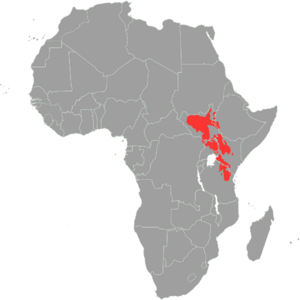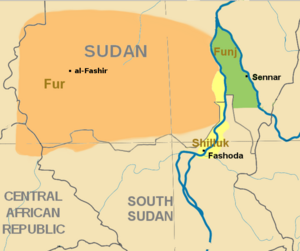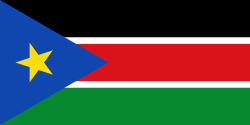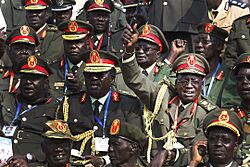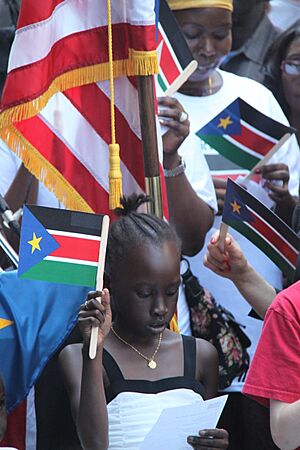History of South Sudan facts for kids
The history of South Sudan tells the story of the land and people of what is now South Sudan. This country's modern history is closely linked to Sudan, its neighbor to the north. This connection started in the 1800s when the Ottoman rulers of Egypt expanded south. South Sudan remained part of Sudan through different periods, like the Mahdist State and Anglo-Egyptian Sudan, until it became independent in 2011.
Most people in South Sudan speak Nilo-Saharan languages. There are also smaller groups who speak Niger-Congo languages. Long ago, the area was mostly home to people speaking Central Sudanic languages. But since about the 1300s, after Christian kingdoms in Nubia fell, Nilotic peoples slowly became the main group in the region.
Contents
Early History of South Sudan
Roman Explorers Reach the Sudd
For many years, the huge Sudd marshland was a big problem for anyone trying to travel along the Nile River. Its thick plants made it impossible to sail through. In 61 AD, Roman soldiers sent by Emperor Nero tried to go up the White Nile. But they couldn't get past the Sudd. This marsh was the furthest the Romans explored into central Africa. Later, finding the source of the Nile was also very hard for the same reason. Explorers had to travel overland from the African coast to avoid the Sudd.
Nilotic Peoples Spread Out
Language studies show that over time, Nilotic speakers became dominant. These groups include the Dinka, Nuer, Shilluk, and Luo. They spread out from the Sudd marshlands. In this area, there is proof from old sites that people raised cattle by moving them from place to place since 3000 BCE. This suggests that Nilotic culture might have been in that area for a very long time.
The Nilotic people started spreading from the Sudd Marshes into the rest of South Sudan around the 1300s. This happened when the Christian kingdoms of Makuria and Alodia in Nubia collapsed. Also, Arab traders started coming into central Sudan. From the Arabs, the South Sudanese might have gotten new types of cattle without humps. This period also shows that Nilotic people started using iron. These changes might explain how Nilotic speakers grew to control the region.
Central Sudanic Groups Remain
Until about 1500, large parts of South Sudan were controlled by people who spoke Central Sudanic languages. A few Central Sudanic groups still live there today, like the Madi and the Moru.
The Powerful Shilluk Kingdom
By the 1500s, the Shilluk were the strongest Nilotic group. They spread east to the banks of the White Nile. Their leader was the famous Nyikang, who is said to have ruled from about 1490 to 1517. The Shilluk took control of the west bank of the river, reaching as far north as Kosti in modern Sudan.
They built an economy based on farming grains and fishing. They had permanent villages along the river. The Shilluk developed a very good farming system. In the 1600s, the Shilluk lands had as many people per square mile as the Nile area in Egypt.
Some historians believe that pressure from the Shilluk pushed the Funj people north. There, the Funj would create their own kingdom, the Funj Sultanate. The Dinka people stayed in the Sudd area. They continued their way of life, moving their cattle to different pastures.
The Dinka were protected and isolated by the Sudd. But the Shilluk were more involved with other groups. The Shilluk controlled the west bank of the White Nile. The Funj Sultanate controlled the other side, and they often fought. The Shilluk could quickly attack other areas using war canoes. They controlled the waters of the Nile. The Funj had an army of armored horsemen. This army helped them control the plains of the Sahel.
Shilluk stories tell of King Odak Ocollo, who ruled around 1630. He led them in a 30-year war with the Funj over control of White Nile trade routes. The Shilluk teamed up with the Sultanate of Darfur and the Kingdom of Taqali against the Funj. But Taqali surrendered, and the Funj won the war.
Later in the 1600s, the Shilluk and Funj joined forces against the Jieng, a Dinka group. The Jieng had become powerful in the area between the Funj and Shilluk. The Shilluk government slowly became more centralized under a king called a reth. The most important reth was Reth Tugo, who ruled from about 1690 to 1710. He built the Shilluk capital of Fashoda. At the same time, the Funj Sultanate slowly fell apart. This left the Shilluk in complete control of the White Nile and its trade routes. The Shilluk's military power came from their control of the river.
The Azande Kingdom
The Azande people, who are not Nilotic, came into southern Sudan in the 1500s. They built the biggest kingdom in the region. The Azande are the third largest group in southern Sudan. They live in the tropical rainforest areas of western Equatoria and Bahr el Ghazal. In the 1700s, the Avongara people arrived. They quickly took control over the Azande. The Avongara rulers stayed powerful until the British arrived in the late 1800s.
The Azande developed kingdoms led by families of Avongara nobles. These nobles had a policy of making conquered people part of their kingdom. They did this by making people serve the king and the noble class. People could become soldiers or farmers. The farmers grew extra food, which was given to those who needed it.
The Azande kingdoms used a special test called "trial by ordeal" to decide if someone was guilty or innocent. They used a poison as an oracle to help them make decisions. When a king died, his sons would be given new areas of the kingdom to rule. This allowed the princes to expand their lands and power, creating their own kingdoms. These conquests brought in people from different groups, including Sudanic, Bantu, and Nilotic. These people then became part of the Azande culture by learning the Azande language. These kingdoms stretched from what is now the Central African Republic to the Democratic Republic of the Congo and modern South Sudan.
Natural barriers, like the Sudd, stopped Islam from spreading into the region. The Dinka people were especially safe in the Sudd marshlands. This protected them from outside groups and allowed them to stay safe without a large army. The Shilluk, Azande, and Bari people had more regular fights with neighboring states.
South Sudan in the 1800s
Egyptian Rule Begins
In 1821, the Funj Sultanate in the north fell to an invasion by Egypt. Egypt was then ruled by the Ottoman Governor Muhammad Ali. The Egyptian forces then moved south. They took control of areas like Kurdufan and Funjistan. In 1827, Ali Khurshid Pasha led his forces through Dinka lands. In 1830, he led an expedition to where the White Nile and the Sobat meet. The most successful trips were led by Admiral Salim Qabudan. Between 1839 and 1842, he sailed the White Nile, reaching as far south as modern-day Juba.
The Egyptian forces tried to build forts and military bases in the region. But sickness and soldiers leaving quickly forced them to give up these bases. Even though the Ottoman rulers of Egypt claimed the area, they couldn't really control it. In 1851, because other countries pushed them, the Egyptian government opened the region to European traders and missionaries.
Europeans found a lot of ivory. But they found that the local Bari were not interested in buying anything they sold. So, the traders often used force to take the ivory. Even this was not very profitable, and the trading businesses did not do well. Christian missionaries also set up posts in the region. But they also had little impact in the early 1800s.
Al-Zubayr's Trading Empire
Since there was no strong government, powerful traders took control in the 1850s. In the east, Muhammad Ahmad al-Aqqad controlled a lot of land. But the most powerful was Al-Zubayr Rahma Mansur. He came to control the Bahr el Ghazal and other parts of South Sudan. Al-Zubayr was a trader from Khartoum. He hired his own private army and marched south.
He set up a network of trading forts called zaribas across the region. From these forts, he controlled local trade. The most valuable item was ivory. In earlier centuries, Sudanese traders did not value ivory highly. But during Egyptian rule, there was a huge increase in global demand. People in Europe and America started buying pianos and billiard balls, which used ivory.
To manage this trade, Al-Zubayr needed many workers. So, he also began to capture a large number of people to work for him. He also made a large army of these captured people. Because of trade disagreements with the Sultanate of Darfur, Al-Zubayr went to war against them. In 1874, he defeated their forces and killed Ibrahim, the last Fur Sultan before Ali Dinar took power again.
The Province of Equatoria
The Egyptian ruler, Isma'il Pasha, was worried about Al-Zubayr's growing power. So, he created the province of Equatoria and planned to take control of the area. Isma'il hired the British explorer Samuel Baker in 1869 to govern the area. He gave Baker soldiers and money. But Baker could not extend Egyptian power over the region.
To get rid of Al-Zubayr, Isma'il Pasha sent a military leader named Muhammad al-Bulalwi. He promised al-Bulalwi control of Bahr el Ghazal if he defeated Al-Zubayr. But Al-Zubayr easily defeated the invaders and killed al-Bulalwi. In 1873, Isma'il Pasha agreed to make Al-Zubayr an Egyptian governor.
Isma'il was still worried about Al-Zubayr's independent power. British newspapers also had many stories about Al-Zubayr, calling him the "Slaver King." In 1874, Charles George Gordon was made governor of Equatoria. In 1877, Al-Zubayr traveled to Cairo to ask to also be governor of Darfur. But Isma'il put him under house arrest. Gordon defeated Al-Zubayr's son, ending the traders' control of the region. Even so, Gordon still could not control any land beyond the small areas around his few forts.
In 1878, Emin Pasha replaced Gordon. The Mahdist War did not reach the non-Muslim areas in the south. But it cut off southern Sudan from Egypt. This left Emin Pasha alone and without supplies. He was rescued by an expedition led by Henry Morton Stanley.
Equatoria stopped being an Egyptian outpost in 1889. Important settlements in Equatoria included Lado, Gondokoro, Dufile and Wadelai. Britain then treated southern Sudan as a separate area. They believed it was at a different stage of development than the north. This policy became official in 1930. In 1946, without asking southerners, the British government changed its policy. They started to unite the north and the south.
Republic of Sudan and Civil Wars
First Sudanese Civil War (1955-1972)
On August 18, 1955, soldiers from the Equatorial Corps in Torit rebelled. These soldiers were local southern Sudanese. They were upset about being replaced by northern Sudanese soldiers. This event, known as the Torit mutiny, started the First Sudanese Civil War. It happened four months before Sudan became independent. Some of the rebels ran into the wild and began a guerrilla fight. In 1962, several rebel groups formed the Anyanya. This became the largest rebel group in southern Sudan.
Talks between rebel groups and the Government of Sudan began in Addis Ababa in late 1971. The World Council of Churches and the All Africa Conference of Churches helped with these talks. These meetings eventually led to the signing of the Addis Ababa Agreement in 1972. This agreement ended the war and created the Southern Sudan Autonomous Region.
Second Sudanese Civil War (1983-2005)
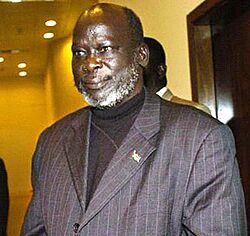
In 1983, Sudan's President Gaafar Nimeiry declared that all of Sudan would follow Sharia law, which is Islamic law. This included the southern region, where most people were not Muslim. The Southern Sudan Autonomous Region was ended on June 5, 1983. This broke the Addis Ababa Agreement.
Because of this, the Sudan People's Liberation Army/Movement (SPLA/M) was formed. It was led by John Garang. This started the Second Sudanese Civil War. Several groups broke away from the SPLA, often based on ethnic lines. These groups were given money and weapons by the government in Khartoum. The most well-known was the SPLA-Nasir in 1991, led by Riek Machar.
Because of fighting among themselves, more southerners died fighting each other than fighting northerners during the war. In the Bor massacre of 1991, about 2,000 civilians were killed by the SPLA-Nasir and armed Nuer civilians. Another 25,000 people died from the hunger that followed in the next years.
In 2005, the Comprehensive Peace Agreement was signed in Machakos, Kenya. It was signed by the Government of Sudan and the SPLA/M. Many groups helped with the talks, including the Intergovernmental Authority on Development, Italy, Norway, the United Kingdom, and the United States. This agreement ended the Second Sudanese Civil War. It also brought back the Southern Sudan Autonomous Region. The agreement also stated that people in southern Sudan would vote on their independence in 2011.
Independence Vote (2011)
As promised by the peace agreement, southern Sudan held a vote for independence in 2011. People voted from January 9 to January 15. A huge 98.83% of voters chose independence, with 99% of people turning out to vote.
At midnight on July 9, 2011, southern Sudan became an independent country. It was named the "Republic of South Sudan." On July 14, 2011, South Sudan became the 193rd country to join the United Nations. On July 28, 2011, South Sudan joined the African Union as its 54th member.
Some disagreements still remain with Sudan. For example, how to share oil money. About 80% of the oil in both Sudans comes from South Sudan. This oil could bring amazing economic opportunities to one of the world's poorest areas. The region of Abyei is still disputed. Even though there were plans for a separate vote to decide who owns it, several problems delayed and eventually stopped an official vote. In July 2011, after a UN decision, Ethiopian peacekeepers started entering the area. This was to stop the armies of Sudan and South Sudan from trying to take control of the area.
Conflict in South Kordofan
On June 6, 2011, fighting broke out between the armies of Northern and Southern Sudan. This happened before the South's independence on July 9. This followed an agreement for both sides to leave Abyei.
By late June, several international groups, including the United Nations, suggested a plan. They proposed to send 4,200 Ethiopian soldiers to Abyei to act as peacekeepers.
South Sudan After Independence
Heglig Oil Field Conflict (2012)
In March 2012, the Sudanese Air Force bombed areas in South Sudan's Unity state. These areas were near the border of Sudan's South Kordofan province. South Sudanese forces fought back by taking control of the Heglig oil field on April 10. Sudanese troops then launched a counter-attack. They forced the South Sudanese Army to leave nine days later. On April 20, South Sudan announced it had started to pull out of Heglig. Sudan, however, claimed it took the area by force. After this, Sudanese president Omar al-Bashir held a celebration rally in Khartoum.
On April 22, more fighting happened on the border. Sudanese soldiers, supported by tanks and artillery, launched three attacks. These attacks went 6 miles (10 km) deep inside South Sudan. At least one South Sudanese soldier was killed, and two were wounded in the attack.
The two countries started talking again in June 2012. The African Union's envoy, Thabo Mbeki, helped them.
On September 27, Sudanese President Omar al-Bashir and South Sudanese President Salva Kiir signed eight agreements in Addis Ababa, Ethiopia. These agreements allowed important oil exports to start again. They also created a 6-mile (10 km) demilitarized zone along their border. The agreements allow 350,000 barrels of South Sudanese oil to be sold to the world market again. Also, the agreements included plans for marking their border, an economic cooperation agreement, and a deal to protect each other's citizens. Some issues are still not solved, and future talks are planned to fix them.
In mid-March 2013, both countries started to pull their forces back from the border area. This was to create a safe zone and allow South Sudanese oil production to start again for export through Sudan. In early April, South Sudanese oil began flowing through pipelines in Sudan again. Although Sudanese President Omar al-Bashir threatened to stop oil transit through his country from South Sudan, South Sudanese President Salvar Kiir accused him of preparing for war. Kiir said he would not go to war over the oil transit issue.
Civil War (2013-2018)
When it became independent, South Sudan was fighting at least seven armed groups. According to UN numbers, these conflicts affected nine of its ten states. Tens of thousands of people were forced to leave their homes. Joseph Kony's Lord's Resistance Army (LRA) also operates in a large area that includes South Sudan. The fighters accused the government of planning to stay in power forever. They also said the government was not fairly representing all tribal groups and was ignoring development in rural areas.
President Salva Kiir claimed that on December 14, 2013, a group from the Sudan People's Liberation Army tried to overthrow the government. This group was mostly made up of Nuer people and was loyal to former vice president Riek Machar. Kiir said the attempt was stopped the next day. However, fighting broke out, starting the South Sudanese Civil War. Machar denied trying to start a coup and ran away. He called for Kiir to resign. Ugandan troops were sent to fight on Kiir's side. The United Nations has peacekeepers in the country as part of the United Nations Mission in South Sudan (UNMISS).
In January 2014, the first ceasefire agreement was reached. But fighting continued, and several more ceasefire agreements followed. Talks were helped by "IGAD +" (which includes eight regional nations, plus the African Union, United Nations, China, the EU, USA, UK, and Norway). After a ceasefire agreement in August 2015, known as the "Compromise Peace Agreement," Machar returned to Juba. He was sworn in as vice-president. After a second outbreak of violence in Juba, Machar was replaced as vice-president. He then fled to Sudan, and the conflict started again. Fighting among rebel groups became a major part of the conflict. Rivalry between Dinka groups led by the President and Malong Awan also led to fighting. In August 2018, another power-sharing agreement was put into effect.
There were ethnic tensions between the Dinka and Nuer in the fighting. About 400,000 people are thought to have been killed in the war. This includes terrible events like the 2014 Bentiu massacre. More than 4 million people have been forced to leave their homes. About 1.8 million of them moved within the country, and about 2.5 million fled to neighboring countries, especially Uganda and Sudan.
See also
 In Spanish: Historia de Sudán del Sur para niños
In Spanish: Historia de Sudán del Sur para niños
- History of Sudan
- Politics of South Sudan
- List of presidents of South Sudan
- National Archives of South Sudan
General:


